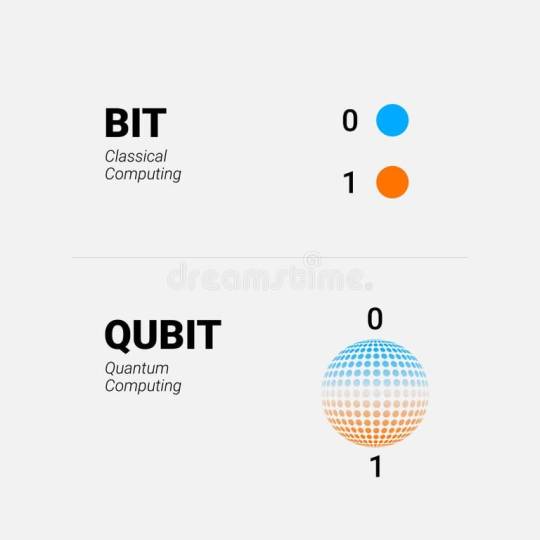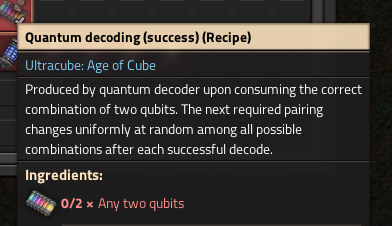#qubits
Explore tagged Tumblr posts
Text
Quantum Computing 101: What are Qubits?
Curious about quantum computing? Let's break it down!

🔍 What’s a Qubit? A qubit is the basic unit of quantum information. Unlike classical bits (0 or 1), qubits can be 0, 1, or both at the same time thanks to a phenomenon called superposition.
✨ Why Is This Cool?
Superposition: Allows qubits to explore many possibilities simultaneously.
Entanglement: Qubits can be linked, so the state of one affects the state of another, no matter the distance.
⚙️ In Action: This means quantum computers can tackle complex problems faster by processing a huge number of possibilities at once!
Follow for more insights on the future of tech! 🚀✨
Instagram: cs_learninghub YT: CS Learning Hub
#quantum computing#quantum#science#physics#computer science#bits#tumblr#aesthetic#studyblr#study#study motivation#qubits#machine learning#artificial intelligence#ai#ml#cs#learn#study blog
21 notes
·
View notes
Text
Craig Gidney Quantum Leap: Reduced Qubits And More Reliable

A Google researcher reduces the quantum resources needed to hack RSA-2048.
Google Quantum AI researcher Craig Gidney discovered a way to factor 2048-bit RSA numbers, a key component of modern digital security, with far less quantum computer power. His latest research shows that fewer than one million noisy qubits could finish such a task in less than a week, compared to the former estimate of 20 million.
The Quantum Factoring Revolution by Craig Gidney
In 2019, Gidney and Martin Ekerå found that factoring a 2048-bit RSA integer would require a quantum computer with 20 million noisy qubits running for eight hours. The new method allows a runtime of less than a week and reduces qubit demand by 95%. This development is due to several major innovations:
To simplify modular arithmetic and reduce computing, approximate residue arithmetic uses Chevignard, Fouque, and Schrottenloher (2024) techniques.
Yoked Surface Codes: Gidney's 2023 research with Newman, Brooks, and Jones found that holding idle logical qubits maximises qubit utilisation.
Based on Craig Gidney, Shutty, and Jones (2024), this method minimises the resources needed for magic state distillation, a vital stage in quantum calculations.
These advancements improve Gidney's algorithm's efficiency without sacrificing accuracy, reducing Toffoli gate count by almost 100 times.
Cybersecurity Effects
Secure communications including private government conversations and internet banking use RSA-2048 encryption. The fact that quantum-resistant cryptography can be compromised with fewer quantum resources makes switching to such systems more essential.
There are no working quantum computers that can do this technique, but research predicts they may come soon. This possibility highlights the need for proactive cybersecurity infrastructure.
Expert Opinions
Quantum computing experts regard Craig Gidney's contribution as a turning point. We offer a method for factoring RSA-2048 with adjustable quantum resources to bridge theory and practice.
Experts advise not panicking immediately. Quantum technology is insufficient for such complex tasks, and engineering challenges remain. The report reminds cryptographers to speed up quantum-secure method development and adoption.
Improved Fault Tolerance
Craig Gidney's technique is innovative in its tolerance for faults and noise. This new approach can function with more realistic noise levels, unlike earlier models that required extremely low error rates, which quantum technology often cannot provide. This brings theoretical needs closer to what quantum processors could really achieve soon.
More Circuit Width and Depth
Gidney optimised quantum circuit width (qubits used simultaneously) and depth (quantum algorithm steps). The method balances hardware complexity and computing time, improving its scalability for future implementation.
Timeline for Security Transition
This discovery accelerates the inevitable transition to post-quantum cryptography (PQC) but does not threaten present encryption. Quantum computer-resistant PQC standards must be adopted by governments and organisations immediately.
Global Quantum Domination Competition
This development highlights the global quantum technological competition. The US, China, and EU, who invest heavily in quantum R&D, are under increased pressure to keep up with computing and cryptographic security.
In conclusion
Craig Gidney's invention challenges RSA-2048 encryption theory, advancing quantum computing. This study affects the cryptographic security landscape as the quantum era approaches and emphasises the need for quantum-resistant solutions immediately.
#CraigGidney#Cybersecurity#qubits#quantumsecurealgorithms#cryptographicsecurity#postquantumcryptography#technology#technews#technologynews#news#govindhtech
2 notes
·
View notes
Text

[Qubits.]
3 notes
·
View notes
Text
The solution is to go into science to get access to a quantum computer that will do this thousands times over for you in the tiniest fraction of a second
But u know… I think your average laptop, that can run factorio, could also probably be made to solve a few hundred operations of this in a few seconds.
36 possible combinations really isn’t that much lol


there are 6 flavors of qubits (using the names from quarks, for some reason) and thus 36 possible configurations. So every time you have a successful decode, it randomizes, and you have to iterate through all the configurations again to find the correct one.
why would you do this to your players? do you hate them? do you want them to go mad building endless logic networks?
496 notes
·
View notes
Text
IBM anuncia progresso em computação quântica com chip livre de erros
A IBM divulgou nesta terça-feira, 10, grandes novidades sobre suas investigações em computação quântica, anunciando um caminho promissor para a criação de um computador quântico que seja livre de erros e capaz de resolver problemas reais nos próximos quatro anos. A companhia estima que em 2029 terá o processador Starling operando, com 200 qubits lógicos, o qual deverá ser capaz de realizar mais de 100 milhões de operações quânticas.(...)
Leia a noticia completa no link abaixo:
https://www.inspirednews.com.br/ibm-anuncia-progresso-em-computacao-quantica-com-chip-livre-de-erros

#ibm#computacaoquantica#processadorstarling#qubits#inovacao#ciencia#novayork#starling#algoritmosqldpc#poughkeepsie#engenharia#desafiostecnologicos#hardwarequantico
0 notes
Text
𝐓𝐡𝐢𝐬 𝐐𝐮𝐚𝐧𝐭𝐮𝐦 𝐂𝐡𝐢𝐩 𝐉𝐮𝐬𝐭 𝐁𝐫𝐨𝐤𝐞 𝐭𝐡𝐞 𝐑𝐮𝐥𝐞𝐬 𝐨𝐟 𝐂𝐨𝐦𝐩𝐮𝐭𝐢𝐧𝐠
Quantum chips are already outperforming supercomputers. From finance to AI, every industry is about to change. Are you ready for quantum disruption?
Watch https://youtube.com/shorts/bEd5MIcgOFY?feature=share
#QuantumComputing#DeepTech#QuantumAI#FutureOfTech#Qubits#YouTubeShorts#QuantumSupremacy#TechRevolution#AIHardware#fraoula
0 notes
Text
youtube
#quantumcomputing#quantumcomputer#computertechnology#computerscience#technology#quantum#quantummechanics#quantumtheory#qubits#artificalintelligence#machinelearning#quantumphysics#computer#computers#computerengineering#quantum computers#Youtube
0 notes
Text
The Quantum Revolution is Here!
Quantum computing is reshaping the future of technology, and the market is expected to grow at a rapid pace, reaching ~USD 1.2 billion by 2024, with a 20% growth rate from 2025-2030. Unlike traditional computers, quantum computers use qubits to perform complex calculations, unlocking new possibilities in fields like cryptography, AI, and drug discovery.
Key Players in Quantum Computing
• IBM
• Google
• Microsoft
• Intel
• Hitachi
• Accenture
Read more about the exciting developments in Quantum Computing - https://www.wissenresearch.com/quantum-computing-in-2025/
Want to stay ahead of the curve? Fill out our contact form to get the latest updates from top companies and startups like Google, IBM, Intel, and more.
Contact: https://www.wissenresearch.com/contact/
Email: [email protected]
#QuantumComputing#IBM#Google#Microsoft#Intel#QuantumRevolution#AI#Qubits#QuantumTech#Computing#Innovation#WissenResearch
0 notes
Text
Quantum Intelligence (QI) and emergence of the Quantum Substrate (QS): The Inevitable Outcome
While classical computing is rooted in binary logic, 0s and 1s, and exists within the framework of classical logic and mathematics, realized through physical hardware, quantum computing, though still realized through physical hardware, harnesses the strange properties of quantum states, such as superposition and entanglements. These properties allow quantum systems to process information in ways…
#artificial intelligence#next-generation technology#quantum communication#quantum computing#quantum entanglement#quantum information#quantum mechanics#quantum physics#qubits#superposistion#technology and innovation
0 notes
Text
Microsoft Cria Novo Estado da Matéria e Produz Chip Quântico Revolucionário

Redmond, 20 de fevereiro de 2025 – A Microsoft anunciou recentemente um avanço monumental no campo da computação quântica: a criação de um novo estado da matéria e a produção de um chip quântico inovador, batizado de Majorana 1. Este desenvolvimento promete transformar a tecnologia computacional e abrir novas fronteiras para pesquisas científicas e aplicações práticas em diversas indústrias.
O Novo Estado da Matéria
Tradicionalmente, aprendemos na escola sobre três estados primários da matéria: sólido, líquido e gasoso. No entanto, a física moderna já expandiu essa lista para incluir estados adicionais, como o plasma e os condensados de Bose-Einstein. A Microsoft, no entanto, adicionou um novo estado à lista: o estado topológico.
O estado topológico é particularmente interessante devido às suas propriedades únicas. Em termos simples, ele se refere a sistemas que possuem fases quânticas protegidas por simetrias topológicas, tornando-os robustos contra perturbações externas. Isso significa que os qubits formados neste estado são extremamente estáveis, reduzindo significativamente os erros que ocorrem em operações quânticas.
O Chip Majorana 1: Uma Revolução Tecnológica
O chip Majorana 1 é um marco na engenharia de semicondutores e supercondutores. Equipado com múltiplos qubits topológicos, este chip permite a execução de cálculos que estão fora do alcance dos computadores clássicos. A chave para essa capacidade reside nas partículas Majorana, que se comportam como suas próprias antipartículas, uma característica essencial para a estabilidade e coerência quântica.
Resfriado a temperaturas extremamente baixas, o Majorana 1 exibe propriedades exóticas que permitem a criação de qubits mais eficientes e menos suscetíveis a erros. Este avanço não só acelera o processamento de informações complexas, mas também promete resolver problemas anteriormente considerados intratáveis.
Implicações Tecnológicas e Científicas
A inovação da Microsoft tem o potencial de impulsionar várias áreas do conhecimento. Na química, por exemplo, os computadores quânticos podem simular reações moleculares com uma precisão inédita, revolucionando o desenvolvimento de novos medicamentos e materiais. Na inteligência artificial, algoritmos quânticos podem acelerar o aprendizado de máquinas, resultando em sistemas mais inteligentes e adaptativos.
A capacidade do Majorana 1 de suportar até um milhão de qubits abre caminho para uma escalabilidade sem precedentes. Isso significa que problemas que exigem vastos recursos computacionais, como a modelagem do clima ou a otimização de redes logísticas, poderão ser resolvidos de forma muito mais eficiente.
Desafios e Perspectivas Futuras
Apesar do entusiasmo, a Microsoft reconhece que ainda existem desafios significativos a serem superados. A produção em larga escala de qubits topológicos e a integração desses sistemas em infraestrutura existente são barreiras técnicas que precisam de soluções inovadoras. No entanto, a empresa está confiante de que, com investimentos contínuos em pesquisa e desenvolvimento, esses obstáculos serão superados em breve.
A estabilidade do estado topológico oferece uma promessa de avanço rápido na computação quântica, acelerando seu desenvolvimento em anos, não décadas. Isso coloca a Microsoft em uma posição de liderança na corrida tecnológica, competindo de igual para igual com gigantes como o Google e a IBM.
Conclusão
A criação do estado topológico e do chip Majorana 1 pela Microsoft representa um marco significativo na história da computação quântica. Este desenvolvimento não apenas redefine as capacidades dos computadores, mas também abre novas fronteiras para a exploração científica e tecnológica. Com o Majorana 1, estamos à beira de uma nova era, onde a resolução de problemas complexos será mais rápida e eficiente, impulsionando avanços que podem mudar o mundo.
#Tecnologia#Inovação#ComputaçãoQuântica#Majorana1#Microsoft#Ciência#EstadoDaMatéria#RevoluçãoTecnológica#AvançoCientífico#IA#Qubits#Futuro
0 notes
Text
Microsoft Unveils Majorana 1 Quantum Computing Chip: A Leap towards Practical Quantum Computers
Microsoft Unveils Majorana 1 Quantum Computing Chip: A Leap towards Practical Quantum Computers @neosciencehub #Microsoft #Majorana1 #QuantumComputers ##QuantumChip #neosciencehub
Microsoft announced a significant advancement in quantum computing with the introduction of its Majorana 1 chip, marking a pivotal moment in the evolution of data processing technology. This chip, which harnesses eight qubits on a compact piece of hardware no larger than a sticky note, symbolizes Microsoft’s commitment to developing quantum devices that could eventually tackle complex problems…
0 notes
Text
ez-Q Engine 2.0: QuantumCTek’s 1000-Qubit Control System

QuantumCTek, a well-known Chinese quantum computing startup, has developed and delivered its groundbreaking ez-Q Engine 2.0 superconducting quantum measurement and control system, advancing the global quantum computing environment. On Monday, June 17, this cutting-edge technology was unveiled that can manage over 1,000 qubits. It advances large-scale quantum computing. Its capabilities and architecture focus on superconducting qubits, a major quantum computing hardware platform.
While meeting globally sophisticated technical standards, the ez-Q Engine 2.0 will cost less than half as much as comparable foreign technology. This impressive combination of cost-effectiveness and high performance should accelerate quantum computing technology commercialisation and make it more accessible for research and development. QuantumCTek supplied this system to the University of Science and Technology of China and China Telecom Quantum Group, two major research institutions.
Quantum Computer Nerve Centre
For quantum computing, the ez-Q Engine 2.0 is the “nerve centre”. Its main task is sophisticated signal production control for quantum devices to make quantum computers work. The fundamental component of RF signal processing is needed to manipulate and read superconducting qubit states. This new system has tenfold better integration than its predecessor, increasing design efficiency and capacity, according to the Anhui Quantum Computing Engineering Research Centre.
Tang Shibiao, head of the Anhui Quantum Computing Engineering Research Centre, stressed the innovation's commercial value. He previously stated, “The cost of controlling a single superconducting qubit with a control system was very high”. Historically, excessive cost has hindered quantum system scalability. But the ez-Q Engine 2.0 solves this problem with a highly advanced and cost-effective solution that is “less than half the price of similar products developed by foreign competitors.”
China's Self-Sufficiency Drive
China's pursuit of quantum computer technology is linked to this discovery. China has been carefully investing in quantum computing to ensure its computer dominance. The ez-Q Engine 2.0 uses domestically made essential components, which boosts China's technical ecosystem and reduces its dependence on foreign suppliers. This measure is part of a bigger national push to dominate quantum technology, ensuring that the essential infrastructure is constructed nationally.
Performance and Verification
QuantumCTek's revolutionary control technology has been extensively tested in quantum computing environments. The ez-Q Engine 2.0's validation on China's 504-qubit superconducting quantum computer demonstrated its endurance and capacity to handle complex large-scale systems. This validation shows it can manage several qubits practically.
It also powered the 105-qubit Zuchongzhi 3.0 CPU. Chinese researchers say that the Zuchongzhi 3.0 can accomplish very complex tasks quadrillions of times quicker than typical supercomputers, demonstrating QuantumCTek's control systems' computing prowess. Validations show that the ez-Q Engine 2.0 is feasible and meets high performance standards.
Increasing Quantum Infrastructure
QuantumCTek has great plans for its cutting-edge control technology. Several universities will receive control services for over 5,000 qubits from the company. This effort represents a strategic push towards larger and more complicated quantum systems to handle more difficult issues. Quantum computing infrastructure in China also grew. This breakthrough would increase China's quantum race standing by providing high-capacity quantum computing resources.
QuantumCTek has a busy innovation pipeline. Wang Zhehui, leader of QuantumCTek's research team and deputy director of the Anhui Quantum Computing Engineering Research Centre, said the company is already developing a next-generation system. This system is expected to handle 10,000 qubits and offer advanced error-correction. Scalable and practical quantum computers require error correction because qubits are brittle and error-prone.
Global Quantum Race Heats Up
The release of the ez-Q Engine 2.0 shows worldwide quantum computing competition growing. The US, China, and many European nations are racing to create useful applications for this new technology. Financial modelling, medical research, and cryptography may change with quantum computing. Quantum computing uses quantum mechanics to calculate complex data exponentially faster. This solves intractable material science, AI, finance, and cryptography issues.
China is a formidable competitor in the global quantum race thanks to QuantumCTek's ez-Q Engine 2.0's high qubit management capacity, cost reduction, and smart domestic component design. The technique is an example of the "Quantum Leap" countries are pursuing to achieve broadly available, large-scale quantum computing.
The official Quantum News portal, Quantum Zeitgeist, routinely highlights quantum computing as one of the most inventive technologies of our day, having the potential to transform many businesses and the planet itself. This QuantumCTek innovation is another breakthrough in the Quantum Zeitgeist and a crucial “nugget of quantum goodness” for the industry.
#QuantumCTek#ezQEngine20#quantumcomputing#qubits#superconductingquantum#Zuchongzhi30#News#Technews#Technology#Technologynews#Technologytrends#Govindhtech
0 notes
Text
Computación Cuántica en Palabras Simples: Cómo Funciona y por Qué Importa
Desde la aparición del primer computador, el mundo cambió para siempre. Problemas complejos que antes parecían imposibles de resolver ahora podían abordarse de forma rápida y eficiente, lo que provocó una evolución imparable de la informática. Los avances tecnológicos comenzaron a surgir a un ritmo casi vertiginoso, como si los computadores hubieran hecho un pacto secreto con el tiempo para…
#bits#cálculos infinitos#computacion cuantica#computador#computadora cuantica#IBM#IBM Q Experience#operaciones matemáticas#ordenador#puerta OR#puertas lógicas#qubits#transistores#verdadero y falso
0 notes
Text
SciTech Chronicles. . . . . . . . .Feb 12th, 2025
#Cancer#metastasize#Digoxin#calcium#DARPA#composite#NOM4D#longerons#qubits#optical#cryogenic#heat#ActivityPub#WordPress#Social#compact#thermoelectric#bismuth-telluride#heatsink
0 notes
Text
Quantum Computing: What the quibit?
Quantum computing is a groundbreaking technological advancement poised to revolutionize the way we process information. By leveraging the principles of quantum mechanics, quantum computers promise to solve complex problems far beyond the capabilities of even the most advanced classical supercomputers. But what exactly is quantum computing, and why is it so transformative? Microsoft Surface Pro 2…
#computing#decoherance#entaglement#google#maxheadroom#metaquest#microsoft#quantum#qubits#superposition#surfacepro2
0 notes